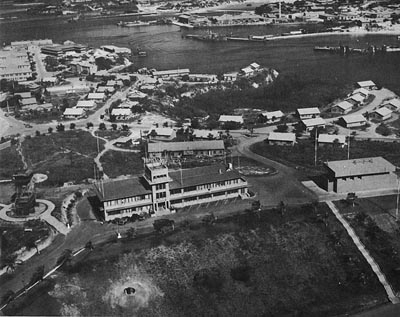Engaging the Base’s Foundations
National Dialogue and Traveling Exhibit
Prior to being introduced to the Guantanamo Public Memory Project, I was unaware of just how much infrastructure plays a role in the movement of people and things. As Arizona State University is preparing an exhibit panel on “Building the Base,” I have come across a great deal of information concerning the physical landscape of GTMO. One of the most interesting pieces of information I encountered was that both the rise and fall of constructions on the base took place between 1939 and 1945. While the increase in construction during this time makes perfect sense due to the onslaught of World War II, with the start of the Cold War in 1947 it would seem that the federal government would continue to increase the size and funding of the base. Throughout our research, we also found that the amount of federal spending in the Caribbean continued to increase after 1945. It is interesting to speculate why GTMO was no longer considered to be the front-lines or a base that required a growing presence of personnel at the entrance of the Cold War.
One of the most interesting photographs I came across in my research was that of the McCalla Field Headquarters on Guantánamo Bay. Several of the sources I examined mentioned the fact that housing was in short supply for the military and contracted civilians during the build-up to WWII. The photo of the McCalla Field Headquarters gives a sense of space for the bay and displays a section of the small amount of personal housing available to those on base. This photo was taken during the escalation in construction and the same area today is likely to look much different than the photo. There were many places on the base that were (some that still are being) torn down, modified and reused. In February of 2012, for example, housing from the 1940s and 1950s was torn down to make way for more manageable and repairable units for those who continue to occupy the base. This is, perhaps, one of the most interesting pieces of information to study; the ways in which the needs of the military have shaped the physical land and even the way it has shaped built structures throughout time. The manner in which a militarized unit builds and maintains a space is quite different from a civilian family’s way of doing the same. Each of the buildings has a industrial look, bare-bones and as basic as possible, to fulfill its specific purpose for being.
While I do not have a great deal of knowledge on naval bases outside of Guantánamo, it would seem that because GTMO was utilized by the federal government at a time of heightened alarm for the country’s safety it would be a useful model to initiate dialogue on current issues. The ways in which the base has been used since its official establishment in 1903 are numerous (naval base, detention center, etc.) and their effectiveness could be measured to gauge whether the same types of actions should be taken on other bases or with other plots of land used by the United States. The ways in which people have moved in, around and through the base throughout its time, and notably prior to its establishment as a base, would be likely to have relevance to other naval installations, as well.
I am looking forward to seeing the ways in which the public reacts to the information on the traveling exhibit panels and how readily they participate in the online forums and SMS function of it. Studying a less controversial––yet still divisive in its own right––side of Guantanamo Bay has been quite intriguing, as it has brought me to the realization that not only was GTMO a detention center, but a place where military families lived, where contracted civilians resided and locals interacted. Such interesting webs of interaction continue to marked the base’s landscape and history.
By Alysa Broughton – Student at Arizona State University
Arizona State University is participating in the Guantánamo Public Memory Project‘s National Dialogue and Traveling Exhibit. Opening at NYU’s Kimmel Center for University Life Windows Gallery in December 2012 and traveling to 9 sites (and counting) across the country through at least 2014, the exhibit will explore GTMO’s history from US occupation in 1898 to today’s debates and visions for its future. The exhibit is being developed through a unique collaboration among a growing number of universities as a dialogue among their students, communities, and people with first-hand experience at GTMO.

